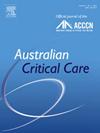Risk factors and 6-month outcomes of paediatric intensive care unit–acquired weakness
IF 2.7
3区 医学
Q2 CRITICAL CARE MEDICINE
引用次数: 0
Abstract
Background
Intensive care unit–acquired weakness results in adverse prognosis, healthcare costs, and resources. Little is known about paediatric intensive care unit–acquired weakness (PICU-AW).
Objective
The goal of this study was to determine risk factors and 6-month outcomes after discharge of patients with PICU-AW.
Methods
From May 2021 to December 2022, a prospective observational study was conducted in a single centre from China. Children aged 7–18 years were divided into two groups with and without PICU-AW at discharge. A predesigned data form was used to collect patients' characteristics. Risk factors were analysed by univariate and multivariate logistic analyses. Outcomes such as muscle strength, functional status, and health-related quality of life (HRQOL) were assessed at 1, 3, and 6 months after discharge.
Results
A total of 172 patients were assessed for eligibility at discharge, and 44 children (25.6%) were diagnosed with PICU-AW. The presence of systemic inflammatory response syndrome on admission (odds ratio [OR]: 6.482, 95% confidence interval [CI]: 2.245–18.712, p = 0.001), higher Pediatric Logistic Organ Dysfunction 2 score on admission (OR: 1.337, 95% CI: 1.011–1.767, p = 0.041), and longer length of stay in the PICU (OR: 1.222, 95% CI: 1.133–1.318, p < 0.001) were significantly associated with PICU-AW. PICU-AW was an independent risk factor for decreased HRQOL at 1 month (OR: 5.215, 95% CI: 1.147–23.715, p = 0.033) and 3 months (OR: 5.318, 95% CI: 1.759–16.077, p = 0.003) after discharge. PICU-AW was not associated with functional status within 6 months after discharge.
Conclusions
The presence of systemic inflammatory response syndrome on admission, organ dysfunction on admission, and longer PICU stays were independent risk factors for PICU-AW. PICU-AW was found to be the independent risk factor for decreased HRQOL at 1 and 3 months after discharge. Children with normal baseline function were more likely to recover their functional status after discharge.
儿童重症监护病房获得性虚弱的危险因素和6个月预后
重症监护病房获得性虚弱会导致不良预后、医疗费用和资源。我们对儿科重症监护病房获得性虚弱(PICU-AW)知之甚少。目的本研究的目的是确定PICU-AW患者出院后6个月的危险因素和预后。方法:从2021年5月至2022年12月,在中国的一个中心进行了一项前瞻性观察研究。7 ~ 18岁患儿出院时分为有PICU-AW组和无PICU-AW组。使用预先设计的数据表收集患者的特征。危险因素分析采用单因素和多因素logistic分析。在出院后1、3和6个月评估肌肉力量、功能状态和健康相关生活质量(HRQOL)等结果。结果172例患者出院时符合条件,44例(25.6%)被诊断为PICU-AW。入院时存在全身性炎症反应综合征(优势比[OR]: 6.482, 95%可信区间[CI]: 2.245-18.712, p = 0.001),入院时儿科Logistic器官功能障碍2评分较高(OR: 1.337, 95% CI: 1.011-1.767, p = 0.041), PICU住院时间较长(OR: 1.222, 95% CI: 1.133-1.318, p <;0.001)与PICU-AW显著相关。PICU-AW是出院后1个月(OR: 5.215, 95% CI: 1.147-23.715, p = 0.033)和3个月(OR: 5.318, 95% CI: 1.759-16.077, p = 0.003) HRQOL下降的独立危险因素。PICU-AW与出院后6个月内的功能状态无关。结论入院时出现全身性炎症反应综合征、入院时脏器功能障碍、PICU住院时间较长是PICU- aw的独立危险因素。PICU-AW是患者出院后1、3个月HRQOL下降的独立危险因素。基线功能正常的患儿出院后更容易恢复功能状态。
本文章由计算机程序翻译,如有差异,请以英文原文为准。
求助全文
约1分钟内获得全文
求助全文
来源期刊

Australian Critical Care
NURSING-NURSING
CiteScore
4.90
自引率
9.10%
发文量
148
审稿时长
>12 weeks
期刊介绍:
Australian Critical Care is the official journal of the Australian College of Critical Care Nurses (ACCCN). It is a bi-monthly peer-reviewed journal, providing clinically relevant research, reviews and articles of interest to the critical care community. Australian Critical Care publishes peer-reviewed scholarly papers that report research findings, research-based reviews, discussion papers and commentaries which are of interest to an international readership of critical care practitioners, educators, administrators and researchers. Interprofessional articles are welcomed.
 求助内容:
求助内容: 应助结果提醒方式:
应助结果提醒方式:


